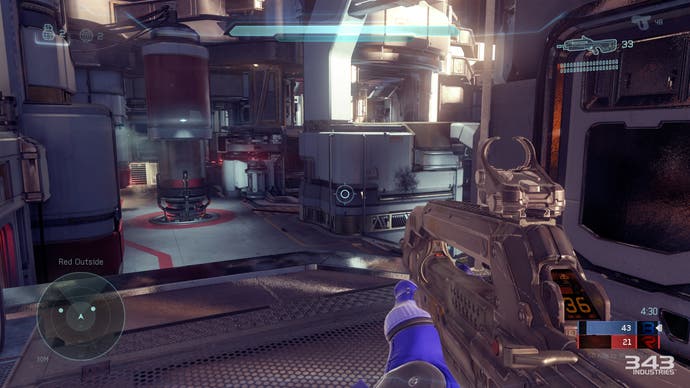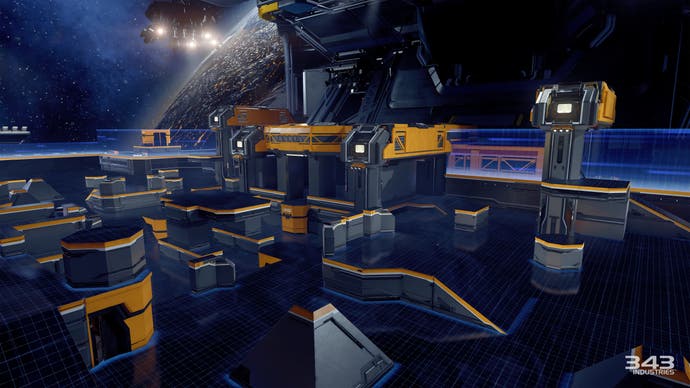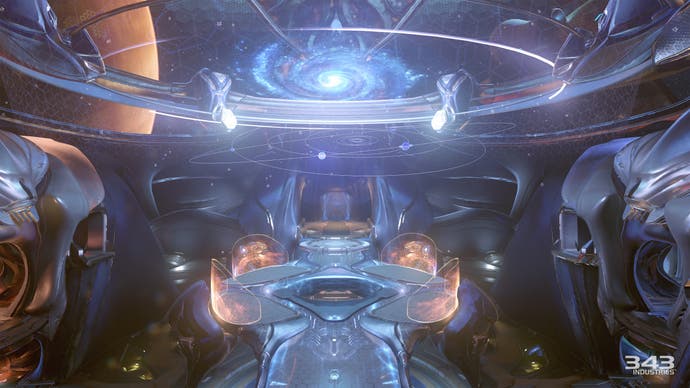Digging deeper into Halo 5: Guardians' new Smart Scope and Spartan Abilities
"It adds to the dance."
Is Halo 5's competitive multiplayer a drastic departure or a return to the series' roots? For me, having played the game for a few hours, it's a bit of both. Fresh and familiar, Guardians' PVP walks a fine line between giving Halo the kick up the arse it perhaps needs on Xbox One, and staying true to what made Bungie's seminal first-person shooter series so special.
People care. And so they should. Halo for so many of us is the console first-person shooter. Hours spent playing split-screen, or maybe online over the fledgling Xbox Live, or maybe both, getting up to no good, no-scoping that Sniper Rifle with the best of them.
Now, just under a year before Halo 5 comes out in time for Christmas 2015, we get a taste of its multiplayer. The beta looms over the horizon. Information is flooding, as much as video game information can flood from a carefully planned PR beat. So it feels like the right time to fuss over the fact that now, pressing the left trigger zooms in for all weapons, clicking the left stick starts unlimited sprint, and a press of the B button boost-dodges your Spartan in any direction. Best to dance now, while there's still time to react.
We've already offered our impressions based on a few hours of Halo 5 hands-on play. Here, in an interview with Eurogamer, studio head Josh Holmes and creative director Tim Longo dig deeper into Halo 5's controversial new Smart Scope system, discuss the new Spartan Abilities, and reveal why returning to a level playing field was so important.
What conversations did you have when you first began to think about multiplayer for Halo 5?
Josh Holmes: The first thing was making sure we have a level playing field for all players. When you look at what we've done with Spartan Abilities, making sure all players have the same set of abilities, all players start with the same weapons, that was critically important. That was one of the biggest changes from Halo 4.
Why was that so important for you?
Josh Holmes: Specifically for arena, that's so important because when you don't have the same set of abilities on both sides, you don't know what your opponent has to use against you. So making sure all players have the same set of abilities, it makes it a little bit more predictable, a little bit more of a chess match, where you know exactly which pieces your opponent has at their disposal.
Tim Longo: We wanted skill to be a really important element of the arena mode. So it's 4v4, and that skill gap is something the game will track with Competitive Skill Rank, but just so players know when they're getting better and how to get better. So there's none of the randomness quality of it.
That's classic Halo, right? But it's not the kind of thing we see from modern shooters, especially on console. We see progression, where you unlock weapons and perks. But you seem to be looking to the past in terms of what you want to do in the future, giving Halo an almost old-school arena feel compared to Halo 4. Was that a deliberate thing you wanted to do?
Josh Holmes: For arena, it's a celebration of Halo's arena multiplayer legacy. For the beta, that was one of the reasons why we wanted to focus on the arena experience. It's on the 10-year anniversary of Halo 2, we're bringing out The Master Chief Collection, and we were talking about what experience we would want to include as part of that. The arena multiplayer experience just felt like it was a perfect fit.
Are you trying to go back to Halo's roots with Halo 5?
Josh Holmes: I think there's definitely an element to that. It's about how we do that and then also evolve it forward.
Tim Longo: We use the roots comment a lot ourselves. I think arena shooters are coming back. I think we'll see more and more of them, and we want to be at the forefront of that, because Halo's always been about that. But add some of our new toys in the toy box, like Spartan Abilities, to expand upon it, so there's still depth - but then the even playing field, because everyone has them, skill will play a big part.
Arena is just the tip of the iceberg for multiplayer, anyway. We're only talking about arena now, but there's more to multiplayer to come for Halo 5 later.

I'd like to talk about the aim down sights debate. In Halo 5 scope applies to all weapons. Traditionally Halo 5 has fire from the hip. In deciding on adding that element to the game for all weapons, were you concerned that the core Halo fanbase would reject it?
Josh Holmes: The thinking was being inspired by the nature of Spartans and what it means to be a Spartan. We went back to canon with the Smart Link system, which has been a part of the Spartans' armour from the beginning. We were thinking, what would it be like to have this intelligent link between your Spartan's armour and your visor and the weapon you're holding? And how could we augment the shooting experience in a way that felt more Spartan-like? That was the first step. Tim talked about the importance of the freedom of mobility, and maintaining that throughout all of the experience.
Tim Longo: It's our version of precision aim, for sure, but again, it's Halo. We wanted it to feel like Halo. We wanted to feel like that helmet and weapon connection that nobody else really does, or can do that. We wanted to embrace that.
And then similar to the Spartan Abilities, we wanted to add another layer of depth within the shooting, just like the Spartan Abilities are with mobility. Hip-fire has its role to play in the run and gun. And Smart Scope does now, too. But they both have their own important checks and balances, so you know when to use one and when to use the other. It's not like one is better than the other, or anything like that.
It's just odd that you can for the first time aim down the sights of the Assault Rifle. Traditionally that's been the default hip-fire weapon. The first time I did that it was a bit odd.
Josh Holmes: When we started playing with the Spartan Abilities and the thrusters, and then linking thrusters and Smart Scope and having the ability to stabalise in mid-air, really gave it its own role and flavour. And then being able to take that and chain it with the thruster abilities, there's some real magic there in how you can move around the map and take advantage of all of these cool Spartan abilities. And then also the fact the maps have been designed specifically with them in mind, just adds a whole layer of depth.
You can go in and play Halo the way you've always played Halo, and then you can start to layer these things on top of it. It adds to the dance.
The Breakout mode doesn't have a radar. It feels pretty brutal!
Josh Holmes: It takes a little bit of getting used to at first. It was a brainchild of our multiplayer design director, who's been thinking about it for years now. It was inspired by paintball. He used to play competitive paintball; one shot, one kill.
Tim Longo: It's higher lethality, but then the round-based thing where you're out. You have to try to eliminate the whole team. It's very paintball centric. That's why it's like, jump in. The map's very simple in its geometry, but we have the cool look with the art direction. But it's all really hard edges, and you really know where your line of sights are. It's really specific. It's definitely hard, but it's hard for both sides equally. There's a bit of a shock for sure.
Josh Holmes: It rewards a lot of communication. That really makes a difference. As you see teams playing more and more together, they'll start to call things out on the map. Even after you've been eliminated, you're then switching between the remaining players on your team and trying to get them information to help them out, to get them through the round. "He's in the house!"
One of the cool things about that mode is it's built in a Forge-able arena. So all of those pieces it's been built out of, those are all modular pieces. Fans will be able to Forge their own maps and create their own Breakout creations and then share those with one another. And then I imagine we'll start featuring those in the game as well.

Halo has had extra mobility for a while with jet packs. But there's extra mobility in Halo 5, with the clamber and the thrusting in mid-air. Ultimately, what's the difference?
Tim Longo: The main difference for me compared to armour abilities in the past is we've tried to integrate it all into the sandbox gameplay as one unit. So, everything is a counter of each other. You stabalise and you're vulnerable, but it's part of Smart Scope. Ground Pound is the same thing: you're up and you're vulnerable. So there's some of that randomness of, who has what? is out of it. But we've even tuned the timing and the damage of those things over and over and over again just to get it right.
Something like the thruster itself, when you hit B, there's a short cooldown. And it's not like you can thrust all the way across the map or anything. We want it to be part of that, oh, I threw a grenade, I meleed, I thrusted. We want it to be a new addition to that triangle of melee, grenades, weapon, now thruster. You're always using all of those things all of the time, and it's integrated, rather than this one-off thing I do occasionally.
Jet pack is like, oh it's jet pack. I have it sometimes and I'll use it over here, but it doesn't always apply.
Josh Holmes: The difference with jet pack as well, is jet pack, while it's a really awesome ability and it gives you that sense of empowerment, it also adds unpredictable verticality, because players can use it anywhere. That means you're always having to worry about having to aim up and dealing with someone who might be coming at you from above.
By focusing on the Spartan Abilities and relying on the map layout, you can have more predictablity. You know when you're in an area within a map that has raised locations where someone can be taking off and pulling off Ground Pound. It's very intentional. You're going to be able to learn that and then react to that and then apply the appropriate strategy to avoid being vulnerable in those situations. Whereas with jet pack you don't have that ability.

Would you say the game is more lethal than Halo 4? Perhaps a bit faster paced?
Josh Holmes: Breakout is definitely more lethal because the tuning in that mode is different. But what we found in Slayer is the lethality is pretty on-par. When you first start playing and you run around with sprint and you're not taking the time to recharge your shields, you're going to die a lot more quickly. As you learn the game and you start to pull back in those situations, the lethality is on a par.
Tim Longo: We've intentionally tried to maintain Halo lethality in Slayer mode. Breakout is separate. That's why all those counter-balances are in there. De-scoping is an important part of that. The damage differentiation from Smart Scope and hip-fire isn't that much, and in some cases not at all. It's more just the zoom and some of the extra information. You can still move. That's the signature of Halo lethality. You need to keep that for Slayer and all the other new modes to make sure it's balanced.
Do you modify damage damage based on whether you're firing from the hip or using Smart Scope?
Josh Holmes: No. There's no increase in the damage per bullet or anything like that. There's some minimal effect on kick on some weapons.
Tim Longo: It depends on the weapon. Sometimes spread of the bullets, or the behaviour of the damage. But the damage itself, we're trying to keep both hip-fire and Smart Scope the same.
So broadly the damage is the same. Can you give me an example of a behavioural change between hip-fire and Smart Scope?
Tim Longo: Spread. Spread of bullets.
Josh Holmes: For example, the SMG, which you might have used, when you free-fire it, it has a very wide spread. When you go into Smart Scope there's a slight narrowing of the spread.
So it's more about precision, so you can target those headshots?
Tim Longo: Yeah. The idea there is that because the scope zooms in, you want the range of the effectiveness of the bullets to adapt with the zoom-in. And you come out to hip-fire when someone's nearby because you want more spread. You want to get their full body. It's hopefully all well-thought through and methodical.
Josh Holmes: The difference between the two is minimal. Part of the challenge there has been to make sure you're not forcing people to go into Smart Scope in order to be effective. We want to make sure players can use the AR, for example, free-fire, and be just as effective as when they go into Smart Scope.
Tim Longo: Something like the DMR, other than zoom there aren't any changes.
Josh Holmes: With the BR, I know they've tuned it so when you're free-fire it's the same as zoom-in. It's been a journey as we've gone through so many different iterations of tuning.
But is this rules are different in Breakout?
Tim Longo: The weapons are all tuned the same. It's only the lethality of your health that's changed. It's just higher lethality, so you have fewer shields. It's decreased numbers, so you go down more quickly. We wanted that tension in Breakout to be higher.
You've confirmed Halo 5 runs at 60fps. What's the resolution of the beta?
Josh Holmes: For the beta, at this point we're totally focused on gameplay. We're mid-way through development. We're balancing and tuning the gameplay systems. All of the polish and optimisation graphically is stuff that typically comes towards the end of the production cycle.
So, for the beta, we're going to be coming out at 720p and 60fps. That's not the final resolution for the game. You can imagine as we go through the remainder of the project we'll be focused on polishing the visual look of the game. You can expect it will look amazing when it comes out.


















